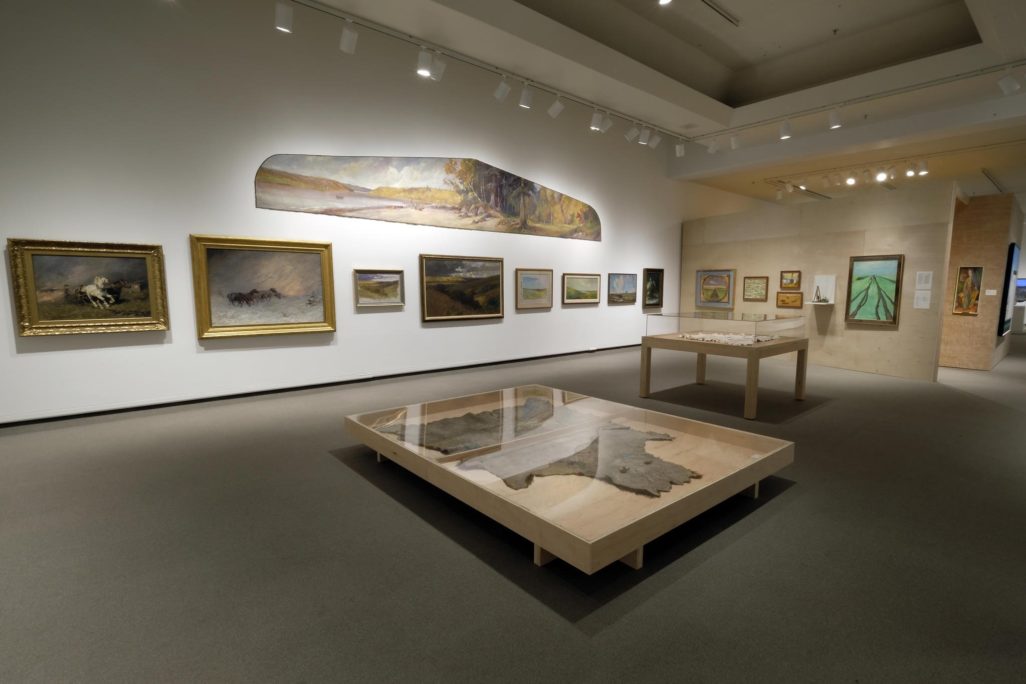The Beginning

Installation view, "The Permanent Collection: Walking with Saskatchewan", 2019, MacKenzie Art Gallery. Photo by Don Hall.
Part of The Permanent Collection: Walking with Saskatchewan focuses on artists who were active in Saskatchewan from the 1920s through the mid-twentieth century. They were, for the most part, the first generation to receive their artistic training in the province; although some of them, such as Stanley Brunst and Robert Hurley, were largely self-taught. The post-secondary educational institutions, such as the University of Saskatchewan and Regina College, offered art instruction during these years, often in the context of teacher training. Influenced to a greater degree by international trends such as Post-Impressionism and Expressionism than the generation of Kenderdine and Henderson, we can see these artists searching for new painterly vocabulary to depict the prairie landscape and experience. Their largely small-scale work found support among their contemporaries and was widely collected even during the years of the Great Depression and the second World War.
The MacKenzie has received several collections formed during these years, and these works have remained popular with successive generations of the Saskatchewan public. Artists such as Art McKay, who would later embrace more contemporary trends in abstraction, began their professional careers working in this representational Prairie modernist idiom. Regions such as the Qu’Appelle Valley and Emma Lake became favourite locales for these artists to portray. The sketching clubs and exhibition societies founded by these artists led to permanent art galleries in both Regina and Saskatoon.
Images of Settlement
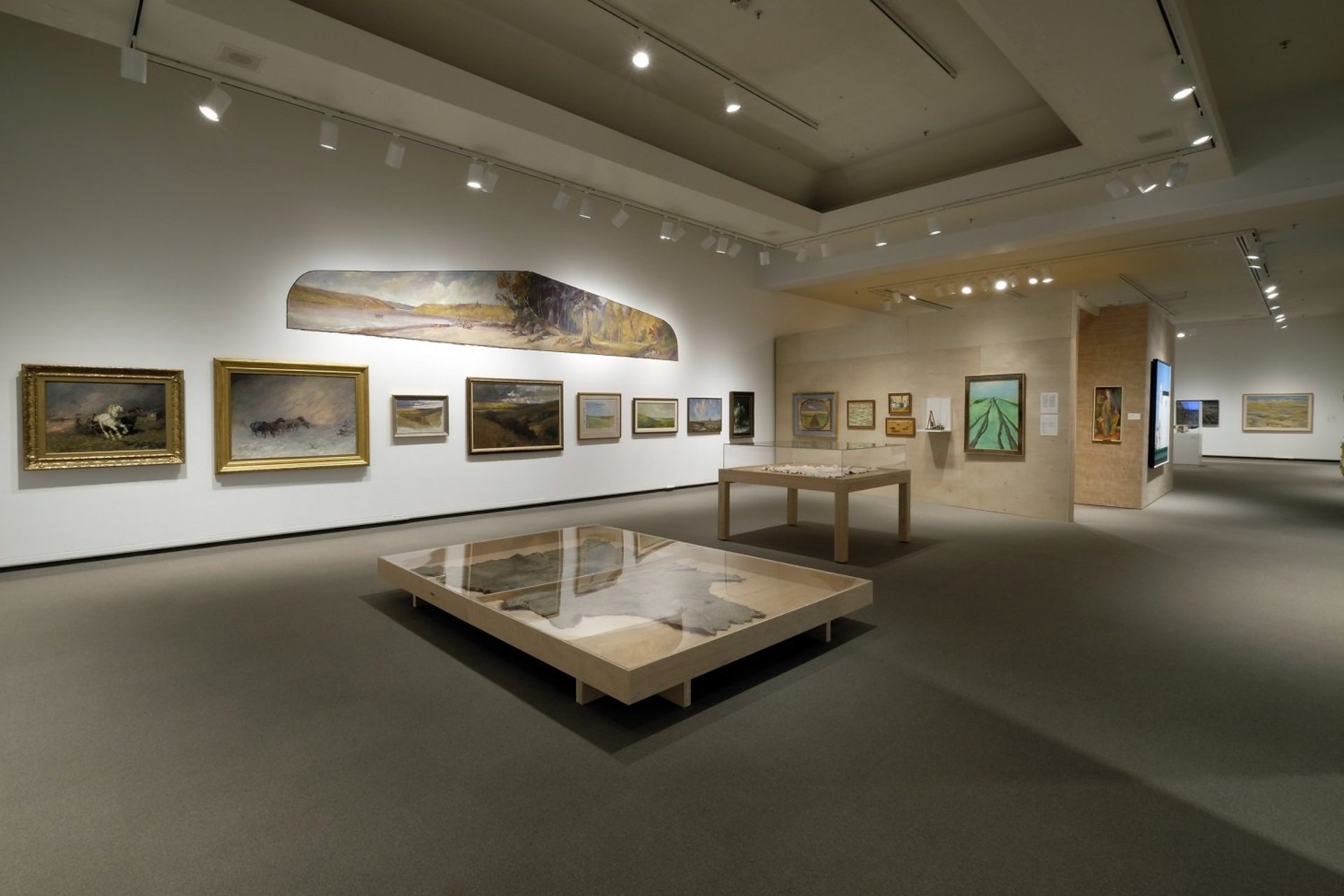
Installation view, The Permanent Collection: Walking with Saskatchewan, 2019, MacKenzie Art Gallery. Photo by Don Hall.
Beginning in the post-Confederation era, public policy encouraged the colonization of the Canadian west through agricultural settlement.
Saskatchewan’s biggest era of population growth was during what social historians refer to as the “Third Wave of Settlement,” between 1890 and 1920. Around 1900 the population was 91,000, by 1911 it had reached 492,000, and by the early 1930s it was 922,000. Canada’s immigration policy in that era gave preference to immigrants from the United Kingdom, and norther and eastern Europe. New arrivals were not informed by the Canadian government of long standing treaty obligations; instead, the Indian Act and discriminatory government policy became the dominant model presented of relations to First Nations. This was in sharp contrast to the Treaty-inspired ethos of earlier times.
Although immigrants to western Canada were encouraged to settle on homestead land as agricultural workers, many came from urban backgrounds and had little farming experience. Poverty, severe winters, lack of social services and other amenities, made for a harsh life. The hardship faced by early settlers stood in stark contrast to the images of bounty circulated amongst immigrants before they made the long and difficult journey to this land. Strangers, often from diverse cultural backgrounds, were dependent on each other for their survival. The values engendered by this experience would shape a unique culture in this province. Consumer and financial co-ops, collective marketing of grain and other products, and eventually, a government that would pioneer publicly funded medical care in North America, were some of the tangible legacies of this hardship. It was also a society where communities resisted the cultural “melting pot;” instead of assimilating into a singular racial majority, many community groups retained and fostered the cultural, religious, and language traditions from their places of origin. This ethnic diversity and creativity can be seen in the architecture of the province’s rural churches and especially in the folk art of self-taught Saskatchewan artists that has received national acclaim.
North West Resistance
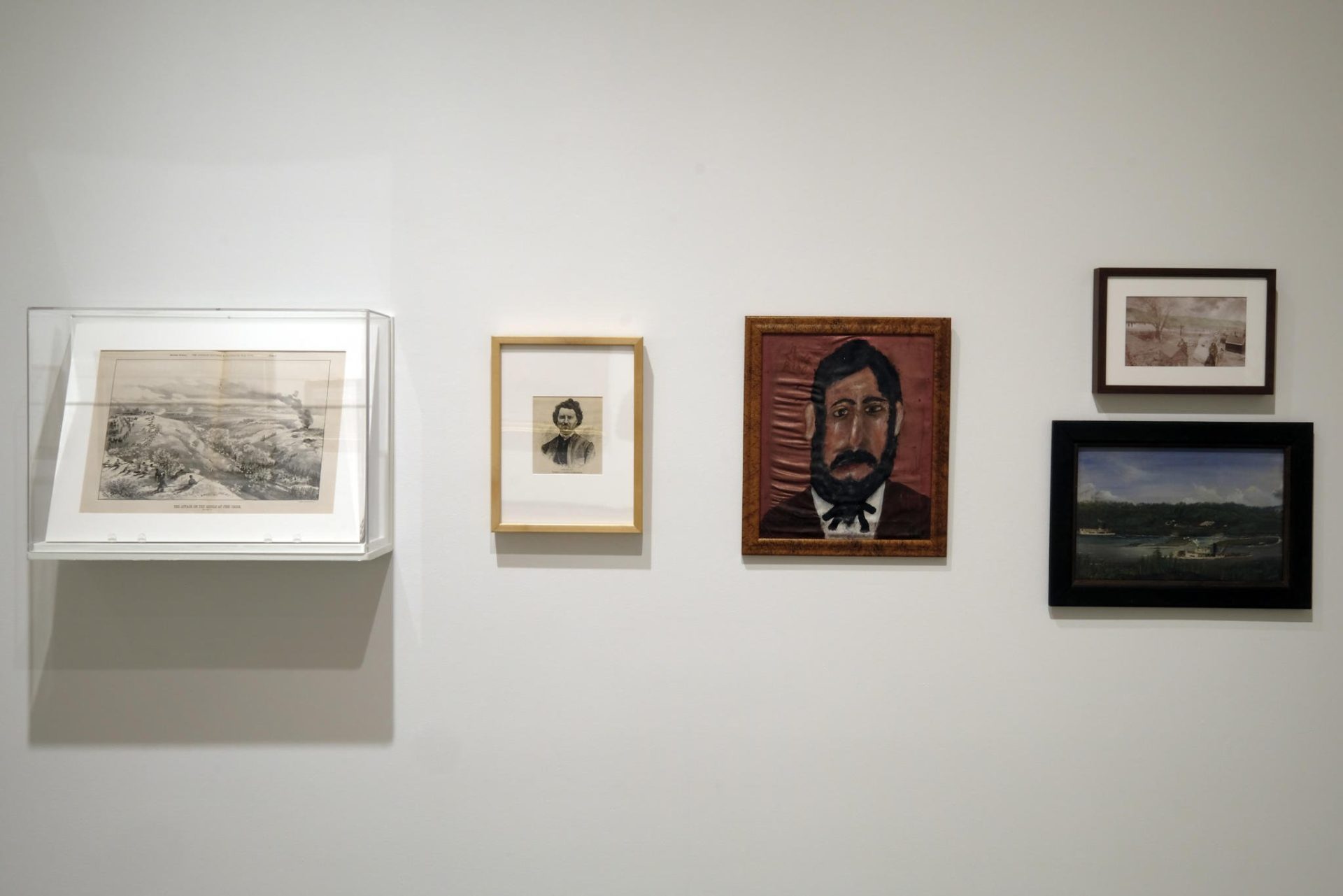
As the political destiny of British-claimed territories in North America began to coalesce in the Confederation era, both eastern Canadian and British expeditions pushed westward across the Great Plains to access the regions’ settlement potential. Part of the goal of these expeditions was to produce publications that were of immense significance in drawing attention to both the agricultural potential for settlement, as well as the region’s natural resources.
The First Nations and Métis peoples of these “Northwest Territories” were well aware of the implications of these political developments. The planned railroad linking eastern Canada and British Columbia, the surveying of these lands, and the sale of the lands claimed by Hudson’s Bay Company to the new Canadian state, all posed serious challenges to the traditional way of life of the region’s inhabitants.
In the region now known as Saskatchewan, these tensions came to a violent impasse in the North-West Resistance of 1885. Refusing to negotiate a political settlement, the Canadian government sent troops to suppress the claims of self-determination by the Métis and their Indigenous allies who were led by Gabriel Dumont and Red River Métis leader Louis Riel. After several battles, Riel and the other leaders were arrested, and Riel was executed in Regina in 1885. Like the expedition publications of the 1860s, the events of the North-West Resistance (which were documented in photographs, folk art and published as wood engravings and lithographs) contributed significantly to the circulation of images of the region in the national imagination.
This portrait of Métis lawyer and political leader Louis Riel was drawn by Henri Julien, Quebec’s leading graphic artist of the era, and published in a popular journal in Montréal at the time of Riel’s trial. It likely served as the model for the anonymous folk-portrait hanging to its right, which is believed to have been used in pro-Riel demonstrations in Montréal. Both images testify to the wide-spread support of the resistance among Francophone Canadians.
While these two portraits of Riel were produced from secondary sources, J.A. Dunn’s painting of the Canadian and Métis allied troops at Fort Carlton were produced from firsthand accounts. Similarly, W.D. Blatchly produced sensationalistic panoramic portrayals of the confrontations between the Canadian forces and the Métis and their allies based on first hand visual documentation. His lithograph of the Fish Creek region strangely anticipates the romantic landscapes of Saskatchewan painted decades later which can be seen in this exhibition. Sitting directly above Dunn’s painting, Mary Longman’s lenticular photograph Hill’s Never Lie brings us into the present by contrasting a contemporary image of herself standing in the cemetery at Lebret with the rich array of wooden memorials in Oliver B. Buell’s photo of the same site in 1885.
Life on the Reserves
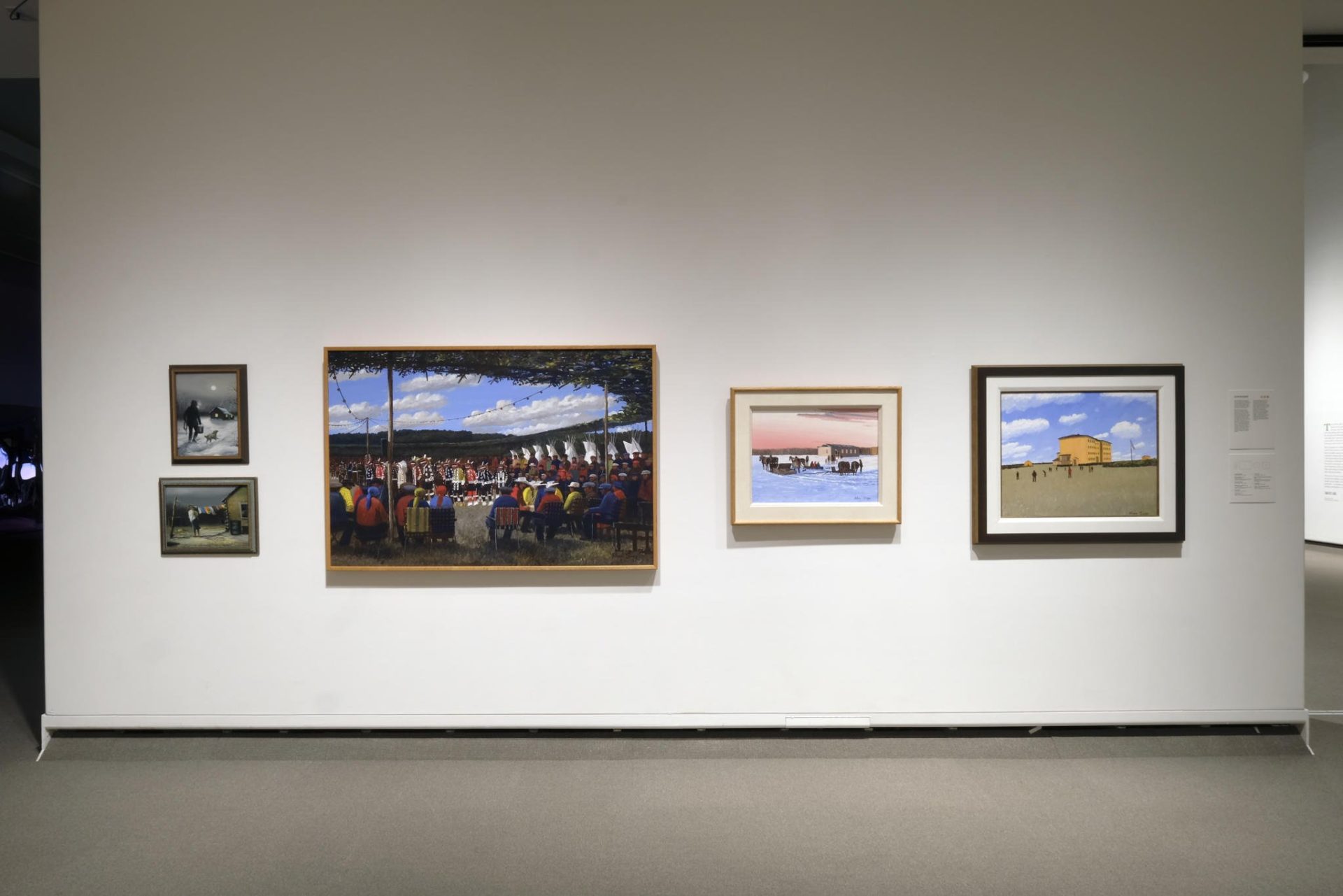
Installation view, "The Permanent Collection: Walking with Saskatchewan", 2019, MacKenzie Art Gallery. Photo by Don Hall.
Self-taught Plains Cree artists Allen Sapp and Sanford Fisher painted from memory their experiences of growing up on Saskatchewan reserves in the mid-century era of the residential schools, the restrictive pass system, and a time when their communities were largely self-sufficient in food production.
Although treaties promised local education to residents of the new reserves, by the 1880s the Federal government chose instead to support regional residential schools run by religious denominations, predominately off-reservation in hopes that the closer proximity to White society would be more effective to assimilate children. Some larger reserves were able to offer their children day schools, but generations of Indigenous youth were taken from their families, often forcibly, as part of a deliberate assimilationist agenda. This was just one of the ways the federal Indian Act was used to negate the contractual commitments of the treaties. Another was the gradual discouraging of ranching, animal husbandry, and other very successful agricultural initiatives of on-reserve residents.
These paintings by Sapp and Fisher reflect these challenging times, for example Sapp’s Going to Christmas Concert in the School shows the community-focused day school, which stands in stark contrast with the isolated children playing in the foreground of his Recess at Onion Lake School, one of the most monumental pictorial expressions of residential school experience. Pow-Wow, on the other hand, boldly and monumentally bears witness to these vital expressions of Indigenous creativity and cultural resilience. In contrast tot the communal gatherings depicted in Sapp’s work, Fisher’s paintings present a more intimate side of reserve life, capturing private moment of domestic work and relaxation.
Post-War Modernisms
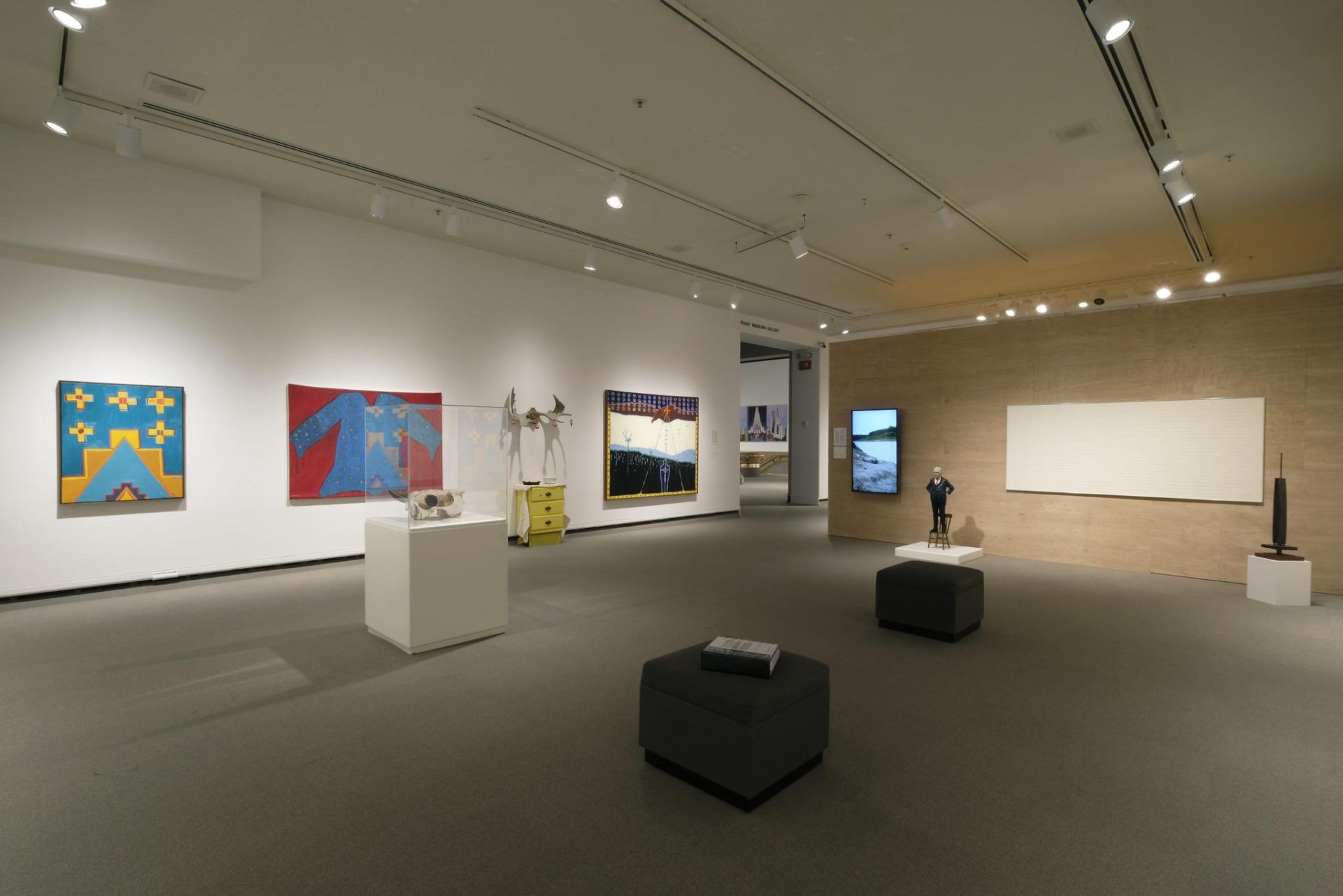
Installation view, "The Permanent Collection: Walking with Saskatchewan", 2019, MacKenzie Art Gallery. Photo by Don Hall.
The trauma of World War Two radically changed the traditional values of Canadian society. The long-established links to British colonial identity were challenged by Britain’s desperate dependence on her allies and former colonies. Returning veterans had no intention of returning to the status quo. Canadians began to see themselves as an autonomous nation within a North American context. Joe Fafard’s sculpture of a defiant John Diefenbaker brings to mind the Saskatchewan-born Progressive Conservative Prime Minister’s refusal to allow the United States to place nuclear missiles in the Canadian north—a foreign policy decision that clearly asserted this new post-war Canadian autonomy. One of the most dramatic expressions of this new trend was the election of the Co-operative Commonwealth Federation (CCF) in Saskatchewan, which formed the first democratic socialist government in North America in 1944.
The CCF implemented a number of radical reforms such as transforming health care, education, resource management, and created Canada’s first publicly funded arts granting body, The Saskatchewan Arts Board (SAB), in 1955. The expressionist-influenced self-portrait of Macgregor Hone, was the first purchase for the SAB’s collection, a clear indication of their forward-thinking mindset, anticipating their continuing support for the province’s contemporary artists.
The SAB, together with the province’s universities, supported the growth of a summer arts program at Emma Lake. Had been started by Augustus Kenderdine in the 1930’s, the program brought in internationally known artists and critics for workshops with Saskatchewan artists. Several of the province’s emerging male artists who participated in the program, including Ronald Bloore, Roy Kiyooka, Kenneth Lochhead and William Perehudoff, embraced a trend towards large-scale abstract painting and sculpture. Large-scale sculpture by their contemporaries Douglas Benthan, Don Foulds, and John Nugent, can be seen in the Mackenzie’s outdoor permanent sculpture garden. Nugent’s maquette for an unrealized monumental minimalist sculpture commemorating Louis Riel can be seen in this gallery. The women participants in the same Emma Lake workshops, Reta Cowley, Dorothy Knowles, and Wynona Mulcaster continued, for the most part, to explore the province’s landscapes, but with a new vitality—or in Lorraine Malach’s case, with a brooding forbearance. During these same years, younger Indigenous artists such as Bob Boyer, Ruth Cuthand, Sheila Orr and Edward Poitras, began exploring large scale painterly abstraction in innovative and dynamic works that drew on their traditions and identity with a new freedom of expression.
During the last decades of the twentieth century, a growing skepticism of modernist ambitions began to arise within social movements, the arts, and society at large. What we have come to know as post-modernism, has had its impact in Saskatchewan as elsewhere. Turning their back on high modernist abstraction, a generation of artists—first working in clay and later in other media—embraced popular culture and regional identity in works that drew more on local folk-artists or traditional practices than on international art trends. This trend can be seen in works by Joe Fafard, David Thauberger, Ruth Cuthand, and Edward Poitras.
Sitting Bull's Robe
Sitting Bull’s robe, on loan to the MacKenzie Art Gallery courtesy of the State Historical Society of North Dakota, is the only buffalo robe known to have been painted by legendary Hunkpapa chief and artist, Sitting Bull (one other robe was painted by Sitting Bull that was gifted to the Vatican, but it has since been reportedly lost). The robe was painted between 1877 and 1881 while Sitting Bull was in the territory now known as Saskatchewan, seeking asylum. The image on the robe features a presumed self portrait of Sitting Bull wearing his strong heart bonnet below a feathered sun that is flanked by two pipes on either side. While Sitting Bull was in Canada he traded with Gus Hedderich at Woody Mountain, and the Buffalo Robe was given to Hedderich by Sitting Bull a few years later. After Hedderich and his wife passed away, the robe was donated to the State Historical Society of North Dakota by M.C. Seekatz in 1945. This will be its first public display in Canada.
In this video, Lakota artist and Knowledge Keeper Wayne Goodwill, a member of Standing Buffalo First Nation, sits down to discuss the robe in more detail.

